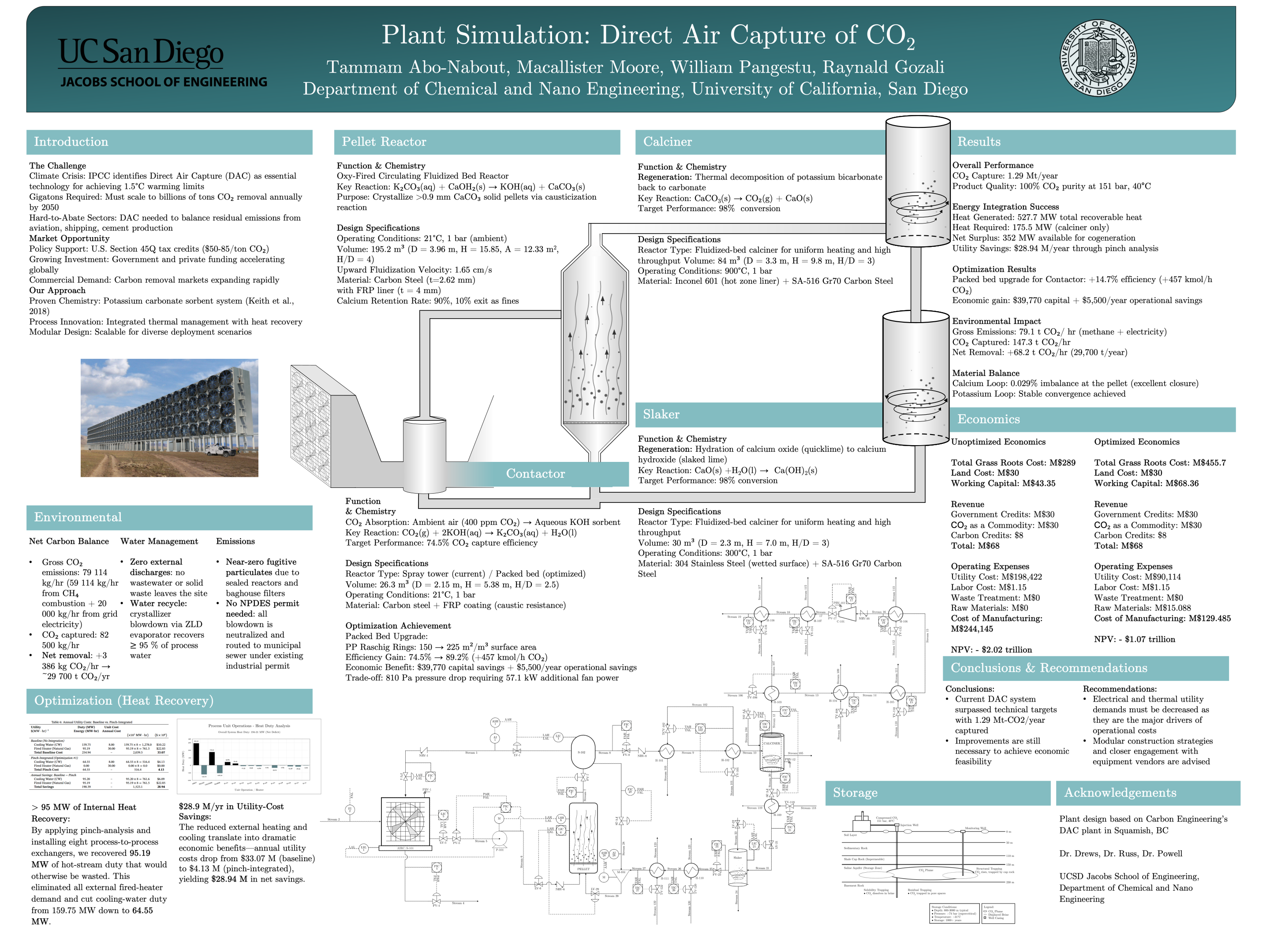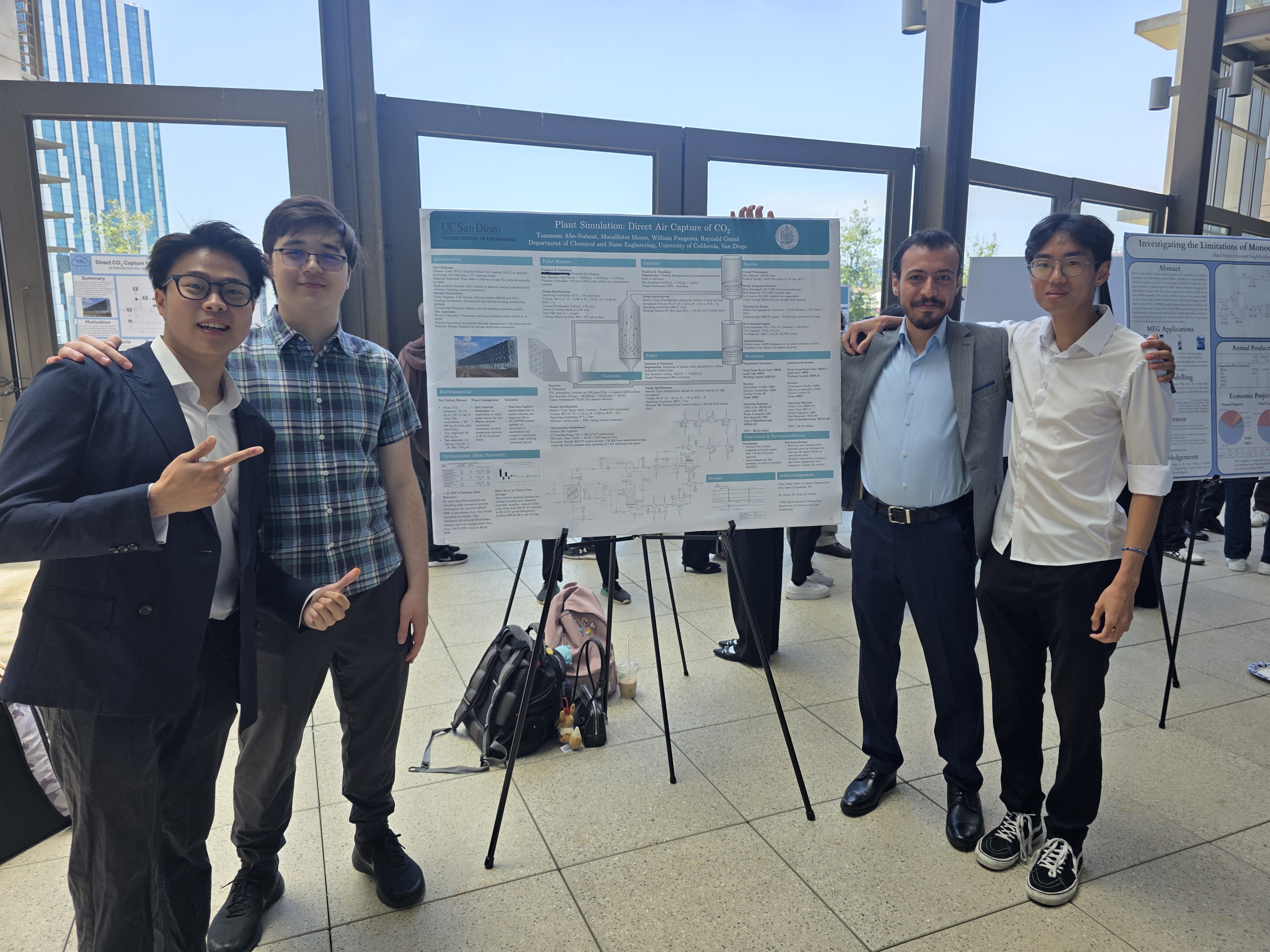Direct Air Capture Plant Design
Senior Capstone Project • CENG 124B • UC San Diego • 2025
Engineering design of a scalable Direct Air Capture (DAC) system capable of removing 1 million metric tons of CO₂ annually from the atmosphere using potassium carbonate-based sorbent technology. This capstone project addresses critical climate change mitigation technology with complete process design, equipment sizing, economic analysis, and optimization strategies for commercial-scale deployment.
Project Scope & Climate Impact
Climate Technology Leadership
Direct Air Capture is recognized by the IPCC as essential for meeting Paris Agreement targets. This project addresses a rapidly growing market with $1.1B global investment in 2023 and strong government policy support through initiatives like the US IRA Section 45Q tax credits.
Industrial Scale Engineering
Complete DAC facility design capable of capturing 1 million metric tons CO₂ annually using K₂CO₃ aqueous sorbent technology. Integrated process includes air contacting, slaking, crystallization, calcination at 900°C, and CO₂ compression for storage.
Commercial Viability
Comprehensive techno-economic analysis demonstrating commercial feasibility with competitive CAPEX and OPEX targets. Process optimization focused on energy efficiency and cost reduction to achieve target capture costs below $600/ton CO₂.
DAC Process Engineering Design
Air Contactor
Atmospheric CO₂ absorption using K₂CO₃ aqueous solution in packed bed contactors. Optimized for maximum gas-liquid contact efficiency and minimal pressure drop.
Slaker Unit
CaO hydration with recycled process water to produce Ca(OH)₂ slurry. Heat integration recovers reaction heat for process energy optimization.
Crystallizer
Precipitation of CaCO₃ and regeneration of K₂CO₃ for recycle. Designed for maximum carbonate conversion and sorbent recovery efficiency.
Calciner
High-temperature thermal decomposition at 900°C using natural gas firing. Produces pure CO₂ stream and regenerates CaO for recycle to slaker.
CO₂ Compression
Multi-stage compression with intercooling to prepare CO₂ for pipeline transport. Includes purification to meet geological storage specifications.
Advanced Engineering Analysis Completed
Process Simulation & Design
- Comprehensive Aspen Plus flowsheet development
- Thermodynamic property modeling for K₂CO₃-H₂O-CO₂ system
- Complete heat and mass balance optimization
- Energy integration and pinch analysis
Equipment Design & Sizing
- Rotary calciner sizing and heat transfer analysis
- Packed bed contactor design and pressure drop
- Crystallizer design with residence time optimization
- Heat exchanger network synthesis and sizing
Economic Optimization
- Capital cost estimation using industry methods
- Operating expense optimization and analysis
- Sensitivity analysis for key design parameters
- Carbon credit revenue and policy impact modeling
Project Management
- Project planning with detailed Gantt chart
- Team coordination and technical leadership
- Risk assessment and mitigation strategies
- Stakeholder communication and presentation
Project Presentation & Team
Technical Poster
Comprehensive project poster presented at the UC San Diego Chemical Engineering Senior Design Symposium, showcasing key engineering results and process innovations.

Senior Design Symposium Presentation • UC San Diego ChE Department
Project Team
Collaborative engineering team that delivered this comprehensive DAC plant design through integrated expertise in process engineering, economics, and project management.

Team 6 • CENG 124B Senior Capstone • Spring 2025
Chemical Engineering Department, UC San Diego
Team Members:
- Tammam Abo-Nabout worked on Contactor (Second from right)
- Mac Moore worked on Pellet Reactor (Second from left)
- William Pangestu worked on Calciner(Left most)
- Raynald Gozali worked on Slaker (Right most)
Complete Technical Report
Comprehensive engineering analysis including process design, equipment sizing, economic evaluation, and optimization strategies for commercial DAC deployment. The report demonstrates mastery of complex process engineering principles applied to cutting-edge climate technology.
Download Full ReportEngineering Performance Achievements
Climate Engineering Impact
This capstone project demonstrates mastery of complex process engineering principles applied to cutting-edge climate technology. The comprehensive design approach—spanning process simulation, equipment sizing, economic analysis, and optimization—showcases the multidisciplinary skills essential for senior engineering roles in environmental technology and sustainable engineering. The project addresses real-world climate challenges while demonstrating commercial viability, reflecting innovative engineering solutions demanded by clean technology industry leaders.